中西方绘画的不同 英文版
- 格式:ppt
- 大小:2.04 MB
- 文档页数:10
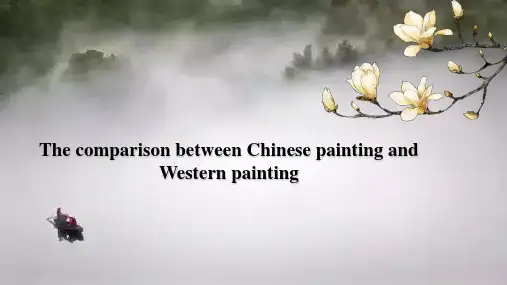
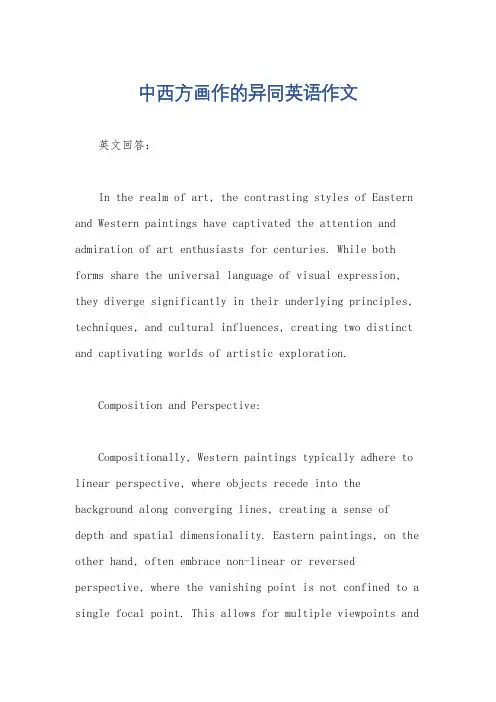
中西方画作的异同英语作文英文回答:In the realm of art, the contrasting styles of Eastern and Western paintings have captivated the attention and admiration of art enthusiasts for centuries. While both forms share the universal language of visual expression, they diverge significantly in their underlying principles, techniques, and cultural influences, creating two distinct and captivating worlds of artistic exploration.Composition and Perspective:Compositionally, Western paintings typically adhere to linear perspective, where objects recede into the background along converging lines, creating a sense of depth and spatial dimensionality. Eastern paintings, on the other hand, often embrace non-linear or reversed perspective, where the vanishing point is not confined to a single focal point. This allows for multiple viewpoints anda more immersive, abstract experience of the subject matter.Subject Matter and Symbolism:The subject matter depicted in Western and Eastern paintings also reflects their cultural differences. Western paintings frequently feature realistic portrayals of human figures, landscapes, and religious scenes. Eastern paintings, on the other hand, often focus on nature, animals, and abstract concepts, emphasizing the interplay between the physical and spiritual realms. Symbolism playsa significant role in both traditions, with Western artists employing familiar biblical or mythological motifs, while Eastern painters utilize motifs rooted in nature, Buddhism, and Taoism.Brushwork and Techniques:The techniques employed in Eastern and Westernpaintings are as diverse as the styles themselves. Western artists tend to use oil paints, which allow for smoother blending, subtle shading, and the creation of intricatedetails. Eastern painters commonly use ink and watercolor on paper or silk, resulting in a more delicate, ethereal effect. The brushwork in Western paintings often emphasizes realism and texture, while in Eastern paintings, it serves to convey a sense of movement, energy, and spontaneity.Cultural Influences and Philosophies:The differences between Eastern and Western paintings stem from their respective cultural backgrounds and philosophical underpinnings. Western painting is rooted in the Greek and Roman traditions of realism and humanism, emphasizing the individual and the external world. Eastern painting is influenced by Confucianism, Taoism, and Buddhism, which prioritize harmony with nature, spirituality, and inner contemplation. These differing worldviews shape the aesthetics, themes, and techniques employed in each tradition.Appreciation and Interpretation:Appreciating and interpreting Eastern and Westernpaintings requires an understanding of their uniquecultural contexts. Western paintings generally demand a more analytical approach, focused on the subject matter, perspective, and technical proficiency. Eastern paintings, on the other hand, invite a more contemplative and holistic experience, encouraging viewers to engage with the emotional, spiritual, and philosophical dimensions of the artwork.中文回答:构图与透视:西方绘画通常遵循线性透视,物体沿会聚线向后方消失,营造出深度和空间维度感。
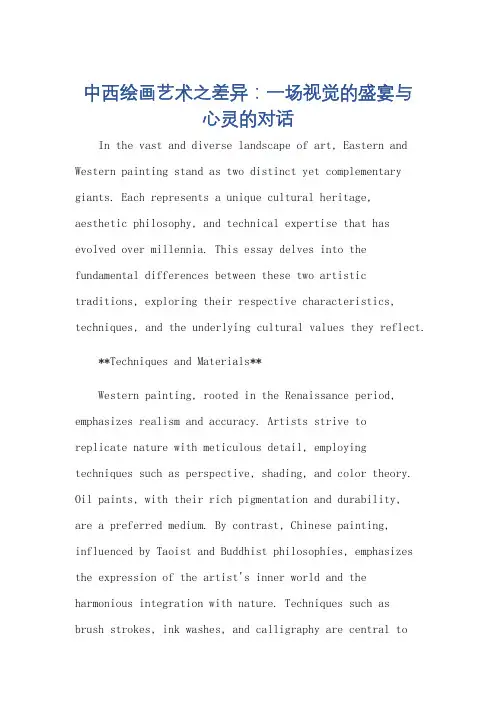
中西绘画艺术之差异:一场视觉的盛宴与心灵的对话In the vast and diverse landscape of art, Eastern and Western painting stand as two distinct yet complementary giants. Each represents a unique cultural heritage,aesthetic philosophy, and technical expertise that has evolved over millennia. This essay delves into the fundamental differences between these two artistic traditions, exploring their respective characteristics, techniques, and the underlying cultural values they reflect. **Techniques and Materials**Western painting, rooted in the Renaissance period, emphasizes realism and accuracy. Artists strive toreplicate nature with meticulous detail, employing techniques such as perspective, shading, and color theory. Oil paints, with their rich pigmentation and durability,are a preferred medium. By contrast, Chinese painting, influenced by Taoist and Buddhist philosophies, emphasizes the expression of the artist's inner world and the harmonious integration with nature. Techniques such asbrush strokes, ink washes, and calligraphy are central tothis art form. Watercolors, with their ability to blend and flow, are the preferred medium.**Representation and Abstraction**Western painting tends toward realism, seeking to replicate the physical world with precision. Artists strive to create a three-dimensional illusion on a two-dimensional surface, emphasizing the details of form, color, and lighting. In contrast, Chinese painting often employs abstraction, emphasizing the artistic expression offeelings and emotions. Images are often simplified and symbolic, reflecting the artist's understanding of the natural world and its place in the universe.**Perspective and Composition**Western painting follows the rules of perspective, with a clear focal point and a hierarchy of elements. Artists carefully compose their works, using lines and shapes to guide the viewer's eye through the scene. By contrast, Chinese painting eschews strict rules of perspective, instead emphasizing the free flow of the brush and the dynamic relationship between elements. Composition is oftenmore flexible, reflecting the artist's personal vision and emotional response to the subject matter.**Conclusion**The differences between Eastern and Western paintingare as vast as the cultural landscapes they represent. Western painting, with its emphasis on realism and accuracy, reflects a culture of scientific inquiry and rational thinking. Chinese painting, with its emphasis onabstraction and inner expression, reflects a culture of introspection and harmonious coexistence with nature. Together, these two artistic traditions offer a rich and diverse visual feast, enriching our understanding of the world and the infinite possibilities of human creativity.**中西绘画艺术之差异:一场视觉的盛宴与心灵的对话** 在艺术的广袤多元领域中,东方与西方绘画犹如两座独特而又相辅相成的巨塔。
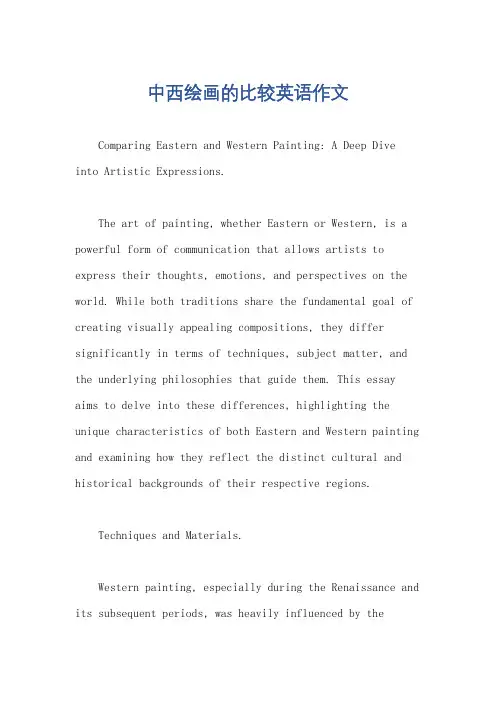
中西绘画的比较英语作文Comparing Eastern and Western Painting: A Deep Diveinto Artistic Expressions.The art of painting, whether Eastern or Western, is a powerful form of communication that allows artists to express their thoughts, emotions, and perspectives on the world. While both traditions share the fundamental goal of creating visually appealing compositions, they differ significantly in terms of techniques, subject matter, and the underlying philosophies that guide them. This essay aims to delve into these differences, highlighting the unique characteristics of both Eastern and Western painting and examining how they reflect the distinct cultural and historical backgrounds of their respective regions.Techniques and Materials.Western painting, especially during the Renaissance and its subsequent periods, was heavily influenced by thescientific principles of optics and perspective. Artists like Leonardo da Vinci perfected the use of linear perspective, creating illusions of depth and space through meticulous attention to detail. This approach emphasized realism, aiming to replicate nature as faithfully as possible. Techniques such as oil painting, with its ability to create rich and luscious textures, further contributed to the realistic quality of Western art.In contrast, Eastern painting, particularly Chinese and Japanese painting, tended to prioritize the expression of the artist's inner world and emotional state. Techniques like ink painting, with its subtle gradations of tone and texture, allowed artists to convey complex emotions and abstract ideas. The use of calligraphy, a form of writing that itself is an art form, further integrated the written word with visual imagery, creating a harmonious blend of form and content.Subject Matter and Composition.Western painting often features realisticrepresentations of people, landscapes, and historical events. From the portraits of Renaissance masters to the grand landscapes of the Impressionists, Western art has traditionally been focused on accurate representations of the physical world. This focus on realism is reflected in the detailed rendering of skin textures, clothing, and natural elements like light and shadow.Eastern painting, on the other hand, often eschewsstrict realism, preferring instead to capture the essence of a scene or emotion. Landscapes, particularly in Chinese painting, are often rendered in a highly abstracted manner, emphasizing the artist's emotional response to nature rather than its literal reproduction. Similarly, figures in Eastern art are often depicted in poses and expressionsthat emphasize inner states rather than literal accuracy.Philosophical Influences.The philosophical differences between Eastern and Western painting are perhaps the most profound. Western art has traditionally been influenced by the notion ofobjectivity, the belief that art should strive to represent reality as it truly is. This objectivity is reflected in the rigorous training of Western artists in the techniques of draughtsmanship and perspective, which aim to create illusions of realism.In contrast, Eastern painting is deeply rooted in the philosophies of Taoism and Zen Buddhism, which emphasize the subjective experience of the individual and the interconnectedness of all things. This perspective leads Eastern artists to prioritize the expression of personal emotions and intuitions over strict realism. The resulting artworks often feature abstract compositions and non-literal representations that are designed to evoke specific emotional responses in the viewer.Conclusion.In conclusion, the comparison of Eastern and Western painting reveals profound differences in techniques, subject matter, and underlying philosophical principles. Western painting, with its emphasis on realism andobjective representation, reflects the scientific and rationalist bent of Western culture. Eastern painting, on the other hand, with its focus on subjective expression and emotional response, resonates more deeply with the mystical and intuitive leanings of Eastern thought. Both traditions, however, share the common goal of communicating human experience and perspective through the visual language of art.The differences between Eastern and Western painting are not just artistic but also cultural and philosophical. They reflect the distinct ways in which different cultures have approached the world and understood their place within it. By examining these differences, we can gain a deeper understanding of not just the art itself but also the histories, beliefs, and values that underlie it.。
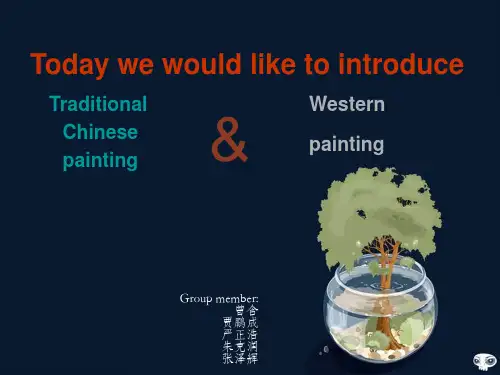


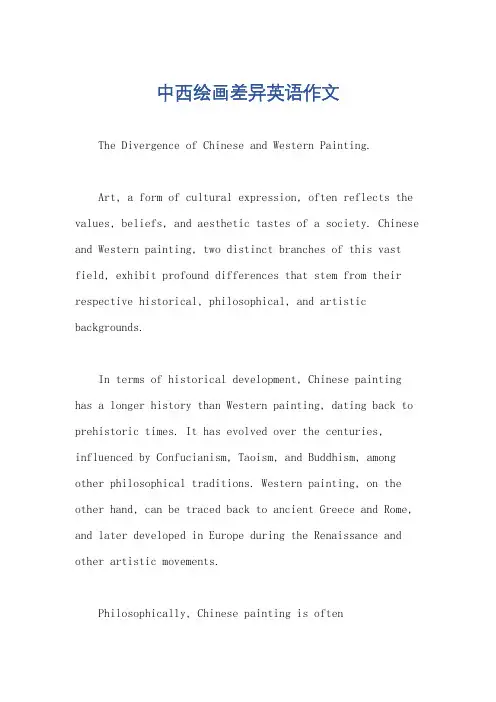
中西绘画差异英语作文The Divergence of Chinese and Western Painting.Art, a form of cultural expression, often reflects the values, beliefs, and aesthetic tastes of a society. Chinese and Western painting, two distinct branches of this vast field, exhibit profound differences that stem from their respective historical, philosophical, and artistic backgrounds.In terms of historical development, Chinese painting has a longer history than Western painting, dating back to prehistoric times. It has evolved over the centuries, influenced by Confucianism, Taoism, and Buddhism, among other philosophical traditions. Western painting, on the other hand, can be traced back to ancient Greece and Rome, and later developed in Europe during the Renaissance and other artistic movements.Philosophically, Chinese painting is oftencharacterized by a harmonious blend of nature and humanity. It emphasizes the unity of heaven and earth, and thepainter's role is to capture the essence of nature and express it through brushstrokes and ink washes. By contrast, Western painting tends to emphasize the individuality ofthe artist and the representation of reality. It strives to create a three-dimensional illusion on a two-dimensional surface, often emphasizing light, shadow, and perspective.Technically, Chinese painting differs significantlyfrom Western painting. Chinese artists use brushes dippedin ink or color to create images on paper or silk. These brushes have varying thicknesses, allowing for intricate detail work and a wide range of expressive strokes. Western painting, on the other hand, typically employs a variety of tools, including brushes, knives, and even fingers, toapply paint to a canvas or other surfaces. The palette of Western painting is also more diverse, encompassing a wide range of colors and textures.In terms of subject matter, Chinese painting often focuses on landscapes, portraits, and figures engaged inactivities of daily life. These paintings are not mere representations but rather convey emotional and spiritual meanings. Western painting, while also including landscapes and portraits, often delves into a broader range of subjects, including historical scenes, religious narratives, and abstract compositions.The aesthetic goals of Chinese and Western paintingalso differ. Chinese painting aims to evoke a feeling or mood in the viewer, often through the use of symbolism and implied meanings. It emphasizes the harmonious integrationof form and content, seeking to express the essence of a subject rather than its literal appearance. Western painting, on the other hand, tends to prioritize realismand accuracy, striving to create a convincing illusion of three-dimensional space and texture.In conclusion, the differences between Chinese and Western painting are profound and reflect the distinct cultural and philosophical backgrounds of the twotraditions. Chinese painting emphasizes harmony,spirituality, and expressiveness, while Western paintingemphasizes realism, individuality, and technical proficiency. Both traditions have made significant contributions to the art world and continue to influence artists and viewers alike.This brief overview of Chinese and Western painting highlights some of the key differences between the two. However, it is important to note that these differences are not absolute, and there have been instances of cross-cultural influence and fusion. As globalization continues to shape our world, it is likely that these two traditions will continue to influence and inform each other, leading to new and innovative forms of artistic expression.。
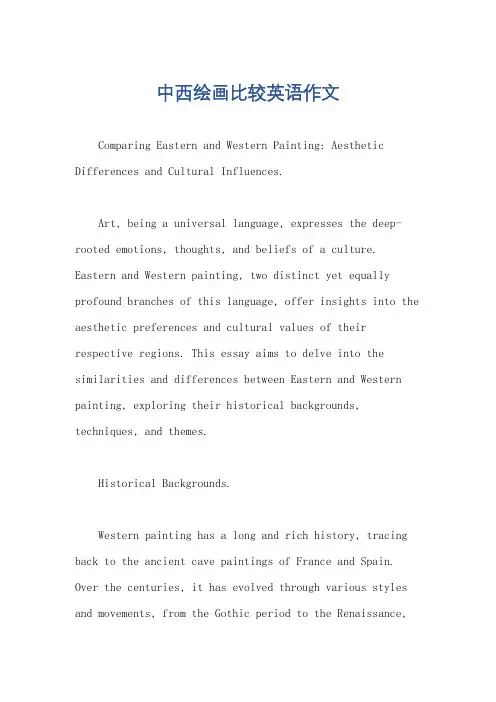
中西绘画比较英语作文Comparing Eastern and Western Painting: Aesthetic Differences and Cultural Influences.Art, being a universal language, expresses the deep-rooted emotions, thoughts, and beliefs of a culture. Eastern and Western painting, two distinct yet equally profound branches of this language, offer insights into the aesthetic preferences and cultural values of their respective regions. This essay aims to delve into the similarities and differences between Eastern and Western painting, exploring their historical backgrounds, techniques, and themes.Historical Backgrounds.Western painting has a long and rich history, tracing back to the ancient cave paintings of France and Spain. Over the centuries, it has evolved through various styles and movements, from the Gothic period to the Renaissance,Impressionism, and Modern Art. Each era has left its unique mark on Western painting, shaping its techniques and themes.On the other hand, Eastern painting, primarily represented by Chinese and Japanese traditions, dates back thousands of years. Chinese painting, in particular, has a profound history rooted in Confucianism, Taoism, and Buddhism. It emphasizes the harmony between nature and humanity, reflecting the philosophical beliefs of the East. Japanese painting, influenced by Chinese traditions, also has its unique styles and techniques.Techniques and Materials.Western painting is known for its realistic portrayalof subjects, achieved through techniques such as perspective, lighting, and shadowing. Oil painting, a popular medium in the West, allows for rich color and texture, creating a lifelike illusion. Western artistsoften emphasize the individuality of their work, seeking to express their unique vision and emotions.In contrast, Eastern painting focuses more on the essence of a subject, often abstracting it from its literal representation. Techniques like ink painting, practiced in both China and Japan, emphasize the flow and rhythm of brushstrokes. Colors are often softer and more subdued, focusing on the harmonious integration of forms and spaces. Eastern artists value the process of creation, seeing each stroke as a part of a larger, continuous dialogue with nature and the universe.Themes and Symbolism.Western painting has traditionally been centered around portraiture, landscape, and historical scenes. Artists often explore themes of human emotion, social commentary, and religious beliefs. With the advent of Modern Art, Western painting has become more experimental and diverse, embracing abstraction, surrealism, and other non-traditional forms of expression.Eastern painting, on the other hand, often features themes of nature, such as mountains, water, flowers, andbirds. These themes are not just representations of the natural world but also serve as vehicles for expressing deeper philosophical and spiritual concepts. For instance, the lotus flower in Chinese painting symbolizes purity and enlightenment, while the cherry blossoms in Japanesepainting represent the brevity of life and the beauty ofits fleeting moments.Conclusion.In summary, Eastern and Western painting, thoughdifferent in many ways, are both powerful expressions of their respective cultures. Western painting, with its emphasis on realism and individual expression, reflects the analytical and objective mindset of Western culture.Eastern painting, with its focus on abstraction and harmony, embodies the intuitive and subjective worldview of Eastern culture.By comparing these two traditions, we gain a deeper understanding of the aesthetic preferences and cultural values that shape them. This understanding not onlyenriches our appreciation of art but also promotes cultural exchange and mutual understanding between the East and the West.。
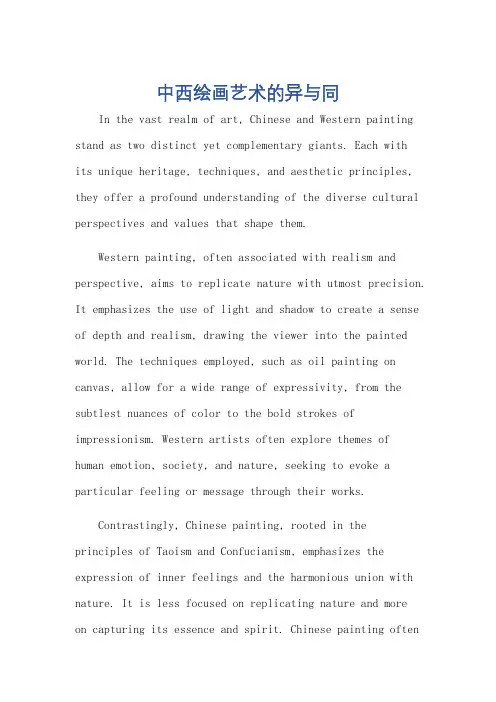
中西绘画艺术的异与同In the vast realm of art, Chinese and Western painting stand as two distinct yet complementary giants. Each withits unique heritage, techniques, and aesthetic principles, they offer a profound understanding of the diverse cultural perspectives and values that shape them.Western painting, often associated with realism and perspective, aims to replicate nature with utmost precision. It emphasizes the use of light and shadow to create a sense of depth and realism, drawing the viewer into the painted world. The techniques employed, such as oil painting on canvas, allow for a wide range of expressivity, from the subtlest nuances of color to the bold strokes of impressionism. Western artists often explore themes of human emotion, society, and nature, seeking to evoke a particular feeling or message through their works.Contrastingly, Chinese painting, rooted in theprinciples of Taoism and Confucianism, emphasizes the expression of inner feelings and the harmonious union with nature. It is less focused on replicating nature and moreon capturing its essence and spirit. Chinese painting oftenutilizes ink and watercolor on silk or paper, allowing for a more abstract and symbolic representation of nature and the universe. Techniques such as brushwork and ink washes create a unique aesthetic, emphasizing the flow and rhythm of the artist's hand. Chinese artists seek to convey a deeper understanding of life, the universe, and the interconnectedness of all things through their art.Despite these differences, there are also remarkable similarities between Chinese and Western painting. Both aim to evoke emotion and meaning in the viewer, using color, shape, and line to communicate a particular message or feeling. Both require years of training and practice to master their respective techniques, and both offer a window into the soul of the artist and their cultural heritage.In conclusion, Chinese and Western painting, while distinct in their approach and techniques, share a common goal: to express the beauty and complexity of the world through the medium of art. They offer unique insights into the diverse cultural perspectives that shape them, and together, they create a rich and diverse tapestry of visual art that continues to inspire and captivate.**中西绘画艺术的异与同**在艺术的广阔天地中,中西绘画犹如两座各具特色、相辅相成的巨塔。
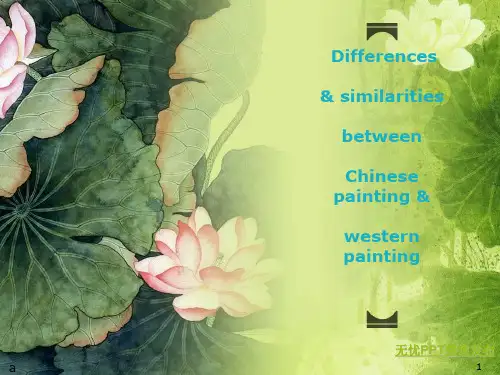
传统的中西绘画区别很多英语作文范文英文回答:Distinctive Features of Traditional Chinese and Western Painting.Traditional Chinese and Western painting hold starkly contrasting aesthetics and techniques, reflecting the diverse cultural and philosophical backgrounds that shape them.Subject Matter and Composition.Chinese painting often depicts nature and landscapeswith a focus on capturing the essence rather than the specific details. The composition is typically asymmetrical, allowing for the artist's subjective interpretation and the viewer's imagination to fill in the gaps. Western painting, on the other hand, tends to prioritize realistic representations of human figures, objects, and scenes. Thecomposition is more structured, often utilizing perspective and vanishing points to create a sense of depth and space.Brushwork and Ink.Chinese paintings are characterized by their expressive brushwork, which conveys a sense of movement, texture, and energy. Ink is the primary medium, varying in tone and thickness to create a subtle range of shades. Western painting employs a wider range of mediums, including oil, acrylic, and watercolor, allowing for more precise rendering and color blending.Color and Perspective.Traditional Chinese painting often uses a limited color palette, with a focus on shades of black, white, gray, and red. Perspective is not strictly adhered to, allowing for the creation of flattened, symbolic compositions. Western painting embraces a full spectrum of colors and utilizes linear perspective to create the illusion of three-dimensional space.Cultural and Philosophical Influences.Chinese painting is deeply influenced by Taoist and Buddhist principles, which emphasize the interconnectedness of all things and the transience of life. The artist seeks to capture the spirit of the subject rather than its physical likeness. Western painting, in contrast, has been shaped by the Renaissance and Enlightenment, placing greater emphasis on humanism, individualism, and the exploration of the natural world.Evolution and Contemporary Practice.Both Chinese and Western painting have evolved over centuries, incorporating new techniques and influences. Contemporary Chinese painters continue to draw inspiration from traditional methods, while experimenting with modern materials and abstract forms. Western artists have also been infused with Eastern aesthetics, leading to cross-cultural fusion and hybrid styles.中文回答:传统中国画和西方绘画的区别。
中西绘画的比较英语作文英文回答:Comparison of Chinese and Western Paintings.Chinese and Western paintings share some similarities but also exhibit distinct differences in their techniques, aesthetics, and cultural influences.Techniques:Chinese painting traditionally emphasizes ink and brushwork, with a focus on capturing the essence of the subject rather than its realistic portrayal. Western painting, on the other hand, employs a wide range of materials, including oil, acrylic, and watercolor, and often strives for visual realism.Aesthetics:Chinese painting values harmony, balance, and the depiction of nature's beauty. It often uses calligraphic brushstrokes, evoking a sense of lyricism and spontaneity. Western painting, particularly during the Renaissance period, embraced perspective, depth, and chiaroscuro (the use of light and shadow) to create a realistic illusion of three-dimensionality.Cultural Influences:Chinese painting is deeply rooted in Taoist and Confucian philosophies, which emphasize the unity of nature and the importance of harmony. Western painting has been influenced by various cultural movements, including the Enlightenment, Romanticism, and Impressionism, each withits own distinct aesthetic and philosophical underpinnings.Differences in Subject Matter:Chinese painting often depicts landscapes, animals, and figures in nature, while Western painting has a broader range of subject matter, including portraits, still lifes,and historical scenes.Use of Color:Chinese painting traditionally uses a limited palette of colors, often with a focus on monochromatic landscapes. Western painting, however, employs a wide range of colors, both natural and artificial, to create vibrant and varied compositions.Perspective:Chinese painting typically adopts a flat perspective, emphasizing the arrangement of elements within the picture plane. Western painting, especially during the Renaissance, developed the use of linear perspective to create the illusion of depth.Narrative and Symbolism:Chinese painting often incorporates narrative elements and symbolism, with objects and scenes carrying specificmeanings. Western painting, while it may also employ symbolism, tends to focus more on the visual qualities of the work itself.中文回答:中西绘画的比较。
中西方绘画艺术的差异英语作文The Divergence of Chinese and Western Painting TraditionsThe history of painting is a testament to the rich cultural diversity of human civilization. From the ancient cave paintings of our ancestors to the avant-garde masterpieces of the modern era, the visual arts have served as a powerful means of self-expression, reflecting the unique worldviews and aesthetic sensibilities of different societies. Nowhere is this more apparent than in the stark contrast between the painting traditions of China and the West.At the heart of this divergence lies a fundamental difference in philosophical and cultural underpinnings. Chinese painting, with its deep roots in Taoist and Confucian thought, emphasizes the harmonious integration of the individual with the natural world. The Chinese artist is not merely a skilled technician, but a cultivated scholar-painter who seeks to capture the essence of the universe through the brush. The emphasis is on the subjective experience of the artist, who strives to convey the spiritual resonance of the subject matter rather than its literal representation.In contrast, Western painting has been heavily influenced by theGreco-Roman tradition, which placed a greater emphasis on the objective representation of the physical world. The Western artist is often seen as a skilled craftsman, adept at rendering the precise details of the natural and human form. The goal is to create a faithful visual record of the observable reality, imbued with a sense of realism and technical virtuosity.These divergent approaches are reflected in the distinct stylistic characteristics of Chinese and Western painting. Chinese painting is characterized by a fluid, calligraphic brushstroke, with an emphasis on the expressive qualities of the medium itself. The composition is often asymmetrical, with a focus on the negative space, or "empty" areas, which are seen as essential to the overall harmony of the work. The color palette is typically muted, with a reliance on subtle gradations and washes of ink.In contrast, Western painting has traditionally placed a greater emphasis on the use of perspective, chiaroscuro (the interplay of light and shadow), and the accurate depiction of three-dimensional form. The composition is often symmetrical, with a clear focal point and a sense of depth and volume. The color palette is typically more vibrant and saturated, with a focus on the representation of natural light and atmospheric effects.These differences extend beyond the purely aesthetic realm,reflecting deeper philosophical and cultural divides. The Chinese painting tradition is rooted in the Taoist concept of the "Dao," or the underlying unity of all things in the universe. The artist seeks to capture the essence of the subject matter, rather than its physical appearance, in an effort to reveal the inherent harmony and interconnectedness of all phenomena.In contrast, the Western painting tradition has been heavily influenced by the Judeo-Christian worldview, which emphasizes the separation of the individual from the natural world. The artist is seen as a creator, imbued with the divine spark of creativity, who seeks to impose order and meaning upon the chaos of the physical universe.These divergent worldviews have also shaped the social and institutional contexts in which painting has been practiced in China and the West. In China, painting has traditionally been closely associated with the scholar-gentry class, who viewed it as a refined and cultivated pursuit, closely tied to the study of calligraphy, poetry, and philosophy. The imperial court and the elite literati were the primary patrons of Chinese painting, and the art form was closely regulated and codified, with strict adherence to established stylistic conventions.In contrast, Western painting has often been more closely aligned with the emerging middle class and the rise of secular institutions,such as art academies and commercial galleries. The Western artist was frequently viewed as an independent creative genius, whose work was subject to the whims of the market and the critical evaluation of the art establishment.Despite these differences, there is a rich history of cross-cultural exchange and mutual influence between the Chinese and Western painting traditions. The introduction of Western-style painting techniques, such as oil painting and perspective, had a profound impact on the development of Chinese art in the late 19th and early 20th centuries. Conversely, the influence of Chinese painting can be seen in the work of many Western artists, who were captivated by the fluid, expressive qualities of the medium and the philosophical underpinnings of the Chinese artistic tradition.In the contemporary era, the boundaries between these two traditions have become increasingly blurred, as artists from both cultural backgrounds engage in a dynamic dialogue, exploring new hybrid forms and challenging the traditional assumptions of their respective painting traditions. This cross-pollination of ideas and techniques has led to a rich and diverse tapestry of artistic expression, reflecting the ever-evolving nature of human creativity and the enduring power of the visual arts to bridge cultural divides and foster mutual understanding.。
中西方画作的比较英语作文Comparing Eastern and Western Art: A Deep Dive into the Unique Expressions of Culture and Aesthetics.Art, a diverse and multifaceted form of human expression, has always been a mirror reflecting the rich tapestry of cultures and traditions. Eastern and Western art, two distinct yet complementary branches of this vast field, have their own unique characteristics and narratives that speak volumes about their respective heritages. Inthis essay, we delve into the differences and similarities between Eastern and Western art, examining their historical backgrounds, techniques, and themes.The historical backgrounds of Eastern and Western art are as diverse as their geographies. Western art has a long and complex history, tracing its roots back to ancient Greece and Rome. During the Renaissance period, Western art saw a significant shift towards realism and humanism, with artists like Leonardo da Vinci and Michelangelo pushing theboundaries of technique and creativity. On the other hand, Eastern art, particularly Chinese and Japanese art, has a longer continuous history, dating back to prehistoric times. Eastern art has always been closely tied to religion and philosophy, with Buddhism and Taoism being significant influences.Techniques and media used in Eastern and Western artalso differ significantly. Western art has traditionally relied heavily on oil painting, watercolor, and sculpture, while Eastern art has employed a wider range of media, including ink painting, calligraphy, and lacquerware. Eastern artists often work with natural materials like bamboo, silk, and paper, creating works that are both delicate and enduring. The brushwork in Eastern art, particularly Chinese ink painting, is renowned for its subtlety and elegance, with artists using different strokes and pressures to convey emotion and texture.Themes and motifs in Eastern and Western art alsodiffer, reflecting the distinct cultural and social milieus of the two regions. Western art has historically beeninfluenced by mythology, religion, and portraiture, with artists often depicting scenes from classical literature or religious texts. Eastern art, on the other hand, has a strong focus on nature and landscape, with artists often portraying mountains, rivers, and flowers with profound emotional and symbolic resonances. This difference in themes is also reflected in the way artists approach composition. Western artists tend to follow a morestructured and formal approach, with a strong focus on perspective and realism. Eastern artists, on the other hand, often adopt a more free-flowing and improvisational style, with less focus on realism and more on capturing the essence of a scene or emotion.Despite their differences, Eastern and Western art also share many similarities. Both traditions have a profound respect for the artist's craft and creativity, with astrong emphasis on technique and practice. Both Eastern and Western artists strive to evoke emotion and meaning intheir works, using color, shape, and form to communicate their ideas and visions. Furthermore, both traditions have been influenced by global cultural exchanges, with Easternartforms like calligraphy and ink painting finding their way into Western art collections and vice versa.In conclusion, Eastern and Western art, while distinct in their expressions and techniques, share a common goal: to capture the beauty and essence of life. Each tradition offers a unique perspective on the world, reflecting the rich cultural heritage and aesthetic preferences of its respective region. By comparing and contrasting these two traditions, we not only gain a deeper understanding of their historical backgrounds and techniques but also appreciate the diversity and beauty of human creativity.。